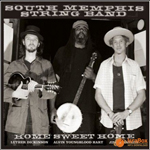The Grateful Dead “Blues For Allah” Audio Fidelity
- Performance:

- Sound:

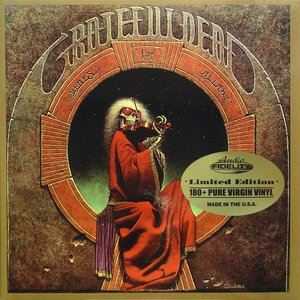
There are some bands that I feel obligated to like. Or at least to try liking. I was a big Black Crowes fan as a kid. Saw them tape the live version of ‘She Talks To Angels” as a 14 year old in Atlanta. Thought they were the greatest rock and roll band of my time and that they were gonna save the whole institution which I knew was broken even at that age. And I still think their second record is pretty classic. They have all the elements that should add up to a winner in my book, but I just can’t bring myself to play any but their first three records now. Similarly, I tried to hop on the Grateful Dead train as a youth, but could never fully commit. I had my ticket, I was standing on the platform in my Birkenstocks, & the train went right on by me. But, for some reason, I can’t give up. I tried getting back into their “One From The Vault” when I moved to San Francisco and rented a place four blocks from the venue where it was recorded. It’s two CD’s worth of music & I made it about to the end of disc one before I bailed. That live recording was a sort of celebration of their recently completed “Blues For Allah” album in 1975. I had such a hard time finding five quality vinyl releases that interested me this month that I picked up Audio Fidelity’s reissue of that same album. I’ve liked some of the Dead’s studio efforts past, and I’ve liked some of the songs from “Allah” that were featured on the first “Vault” CDs. I’m just not sure I like them so much now. That doesn’t mean this isn’t a must-have for Deadhead vinyl collectors. In fact, I think it probably is. Gather up your turquoise & fry yourself a zucchini dog. This is a wild ride…
“Blues For Allah” is like a microcosm of my entire Grateful Dead experience. It’s made up of songs that are alternately engaging and fun, and songs that are hard to hear from start to finish. Side one is pretty strong as far as this kind of thing goes, I think. This is the era of Donna Godchaux on vocals that worked so well for me in high school. Maybe “high” is the operative word. These songs aren’t gonna change your life, probably, but at least they’re songs. Mostly. The two “parts” that comprise “King Solomon’s Marbles” might be the exception. Still, the instrumental is compelling enough. Seems to have some direction and aim. I’ve always liked “Help On The Way.” I still do. In fact, I’ve always liked Jerry Garcia & I still do. I like the way he sings, I like the way he plays, & I often like the lyrics of the tunes he sings whether he writes them or someone else does. I guess he made good decisions, musically at least. That whole heroine in the BMW thing didn’t seem to work too well for him, but that’s immaterial. Bob Weir’s another story all together. He must have been a hell of a guy to be allowed to hang around as long as he did. He got it right on occasion & one of those occasions was on “The Music Never Stopped” which features Godchaux & closes side one. That one gets in my head and hibernates there for seasons at a time. Almost to the point of madness. I just think it’s well arranged and kinda fun. It’s about as close to hippie as I get. Where’s my patchouli? Unfortunately for me, things go down hill in a hurry from there, brothers and sisters. I’m here to tell you I’d rather listen to the ringing in my ears than most anything on side two. “Crazy Fingers” is the exception. Garcia sings it, it’s got a little reggae feel to it, it’s more than listenable. It’s good. The rest is the opposite of listenable. I can’t imagine anyone spending the time to record these “songs” let alone sitting through the initial playback, nodding their collective head in agreement & saying “yep, this is ready to go. The work’s been done.” I mean, we all know about the rampant drug abuse, but wasn’t there at least five minutes of sobriety? Enough time to give this material an honest listen and avert this disaster? Maybe I’m being too harsh, but I’m actively trying to like this record. I guess I’m just not cut out for hearing songs called “Sand Castles & Glass Camels.” The flute has never held much allure for me in a rock context either. I’ve gotta wave the white flag on this one. But here’s the thing that’s so confusing to me: there are lots more high-quality Dead reissues coming. And I’m a little excited about them. MoFi is doing “Mars Hotel,” and “Skull & Roses” amongst others, & I’ll probably buy them. I’ve just got it in my head that I like both of those records specifically. I’m not giving up. I feel compelled. I don’t know why, especially considering my recent failure to rekindle any affinity for the Crowes. And most especially considering I’m presently listening to “Allah” lyrics like “What fatal flowers of darkness bloom from seeds of light.” Sheesh!!
If you’re a true GD fan, then you already have this record and I’ve offended every (hemp) fiber of your being. If you’re a casual fan of songs like “Ripple” or if you’re looking for a Dead entry point, I’d avoid this album like nuclear radiation. The actual recording is top shelf. The texture is clean, but not sterile. Plenty of separation between instruments and voices. Side two just separates me from my sanity. Audio Fidelity’s version is pristine. The record is flawless, the cover sturdy, the inner sleeve is not horrible. It’s a numbered limited edition. It’s pretty compelling, but not enough so that I’m gonna rush out and buy their reissue of the disco era “Shakedown Street.” And I’m about to make a dive for the volume knob right now before my ears fall off. Good luck with this one.
Loretta Lynn “Van Lear Rose” Third Man Records
- Performance:

- Sound:


As forecasted, Big Jack White makes another appearance in this month’s vinyl round-up, this time as producer/player on the acclaimed Loretta Lynn release, “Van Lear Rose.” This one’s from 2004, but this is its first vinyl incarnation. I can’t imagine why, but I’m glad it finally surfaced. Better late than never and all that stuff. I feel like whining about having to wait this long, but I’ll spare everyone’s ears and minds for now. This album won awards. Big ones. The biggest, in fact, which I suppose is the vaunted Grammy. For once, they got something right. I have no idea what was happening in the world of “Country Music” in 2004, but I’ll bet all of Hazard County that it didn’t involve Country Music. And, to be fair, award winner “Portland, Oregon” isn’t what I think of as Country either. It won Best Country Collaboration With Vocals which sounds like it was made up on the spot specifically to honor Ms. Lynn. No one is more deserving of a fabricated, prestigious, puffy award if that’s the case. This is where it’s at, folks. Don’t wait until you’re done reading this article to pick it up. Do it now. Just do it.
I don’t even know where to start. Big Jack must have a thing for brunettes of a certain vintage. His work with Wanda Jackson was a head turner last year too. The two records have entirely different vibes so comparisons are pointless. The do have two things in common: Big Jack and undeniable awesomeness. Awesomeness. Sounds like a word made up on the spot specifically to honor Ms. Lynn. The title track starts the show, and is the record’s strongest tune in my book. The Grammy People, who I imagine living underground in a Fraggle Rock kind of arrangement, must have disagreed. Or maybe they didn’t have time to invent another award for that one. Regardless, it’s undeniably awesome for Country fans in general, and fans of good music as a whole. It’s a repeater in digital format, but I wouldn’t wear the grooves on my new record in such an uneven fashion so giddily I sit through the whole show every time. It’s a short performance. A one-act play at just under forty minutes which lends an even more authentic energy to the listen. It’s got some spoken word pieces, Country gold titles like “Miss Being Mrs.,” and loads of fun for the whole family including an Appalachia stomper called “High On A Mountain Top.” We are, after all, discussing the coal miner’s daughter. And you find coal in a mountain, people. This record, and others like it, offers you a chance to get a little of that backwoods, miner town flavor minus the black lung. (I’m not making light of black lung. I don’t like hearing about it and hope for a day when it’s gone for good. No one deserves that and I’d feel better in a world that didn’t run on energy made by contracting fatal diseases. Enough about that.) Another interesting thing about this record is that Loretta wrote or played a hand in writing every song on it for the first time in her career. Said career began around 1960 when Lynn was about 25 after her husband of twelve years bought her a guitar. Chew on the math for a moment, why don’t ya? Anyway, I hope Loretta got as much of a charge out of that bit of trivia as I did learning of it. I hope she feels accomplished and redeemed and validated as an artist and all of these wonderful things. Because she deserves it, and I’m happier with “Van Lear Rose” in my vinyl collection than I was without it. I’ll dig in to the back catalog poste haste if I can find any of her work in serviceable condition at this late date. If not, my Loretta collection will be ably represented by “Van Lear Rose.” I can’t even bring myself to abbreviate its title for this write-up. It’d be like meeting Loretta Lynn and not calling her “ma’am” or like wearing a hat at her dinner table. Not gonna happen.
And the pressing on this one is impressive enough too. Big Jack’s Third Man Records group generally does a pretty good job with this sort of thing. There have been some inconsistencies in the past, mostly with regards to the pressings. The White Stripe reissues from last year were amazing, and Lynn’s record is in that same vein. The visuals aren’t absolutely perfect, but the sonics are close to it. You get a lyric insert along with a cool little essay by Loretta on the actual inner sleeve. Of course, the inner sleeve is of the paper variety so that’s been replaced by a MoFi inner, and I just keep the original in the sleeve with the rest of it. The cover is old-fashioned and sturdy as a snuff box. There’s a name for this style of cover with the image stickered to the sleeve as opposed to being printed directly on it. I forget the name, but I like the practice. It’s another benign bonus of a quality vinyl release that I get a little pick-me-up from. Sometimes it doesn’t take much. Sometimes it takes a while. The “Van Lear Rose” vinyl release took some time, but it’s finally here for us. I wouldn’t miss it if I were you.
The Band “Stage Fright” Mobile Fidelity Sound Labs
- Performance:

- Sound:

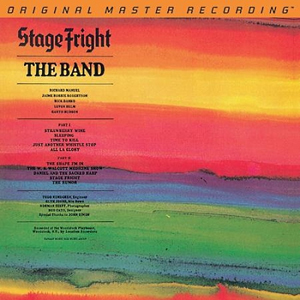
The Band is one of my favorite musical outfits of all time. They’re tricky because the impression they made is huge, but it was formed from very little source material. Most folks can agree that their first two records are classics, but things get a little murky after that. They have some stellar live sets to recommend them, but their studio work after the “brown” album is a little suspect if you ask me. I mentioned as much while I was slaughtering Robbie Robertson’s latest release in April. The material and production on that one is painful. I can hardly think about it without flinching. The Band’s material is generally solid, but they abandoned their rootsy sound after their first two long players in favor of more polished production. In my opinion, the material doesn’t lend itself to polish. It’s best enjoyed raw and unfiltered. Like Kombucha. What’s more, the group took over their own production duties for “Stage Fright” so there’s really no one else to point fingers at if the sound is disagreeable to you. The Band is accountable. Fortunately, Mobile Fidelity is up to their old tricks and they’ve picked this one up for reissue. Their work actually made a couple of Elvis Costello records sound better than the originals, and I think they’ve done it again. I couldn’t really get into “Stage Fright” when I was a kid due to the sonics, but I’m enjoying it much more on this go ’round. Maybe I’ve mellowed, but anyone that’s sat with me in a traffic jam would dispute that. I honestly think the MoFi version of “Stage Fright” sounds better than the original. I’m not gonna wear it out, but I’m glad I have it. It’s a nice addition to my Band collection. Hopefully, MoFi will buy the rights to “Rock Of Ages” too. I couldn’t find anything on the company’s website to suggest that there’s more Band material on the way, but they seem to be turning out multiple titles by the same artist elsewhere. Let us pray.
I don’t think “Stage Fright” had any chart topping hits on it which is confusing since “The Shape I’m In” is on here. If that song’s not a classic, then I’m not sure what is. I can think of plenty of tunes I’d replace on classic rock radio with it, but that probably goes without saying. It’s easily the most compelling tune on “Stage Fright,” but that shouldn’t discredit the title track either. Rick Danko’s vocal performance really shines on that one which is an accomplishment in itself when you’re in a band with singers like Levon Helm and Richard Manuel. Most of the stronger material on “Stage Fright” beyond those two tracks have some sort of novel angle attached to them. “The W.S. Walcott Medicine Show” and “Daniel and the Sacred Harp” are both good songs, for instance, but both are equally hokey in my mind. The Band made good use of lyrical humor as a general practice, but I prefer humor as seasoning to humor as foundation. At least where rock and roll is concerned. And I don’t mean that the two tunes are Weird Al worthy or anything. They both rock enough, I guess, but they feel a little light to me in comparison to the work that I think makes this group great. “Strawberry Wine” is a serviceable album opener, and it swings mightily even if the production is a little humid for my taste. It just feels a little heavy and thick, like a blanket’s been thrown over the speakers or something. These tunes would sound so much more compelling to my ears had they been given a treatment more in line with the “brown” record. Or even the “Basement Tapes,” but that’s asking for too much. Or, more accurately, too little. I have similar issues with the bulk of Bruce Springsteen’s catalog. I wish he’d go back and re-record everything past “Born To Run.” I guess that’s why it’s so nice to have MoFi pick up a title like this one. This is undoubtedly the closest we’ll get to a do over on these tunes as two of the five members are now deceased, and Levon Helm seems to detest the air that Robbie Robertson breathes. If that’s how it’s gonna be, then this version of “Stage Fright” will be the definitive one in my mind.
I guess the danger of being in a successful rock and roll band, beyond the STD’s, is that you’re often expected to live up to your previous output. You’ve got your work cut out for you if your previous record is on a par with “Music From Big Pink.” I don’t think “Stage Fright” gets there. Or even close. But it’s a fine rock record when judged on its own merits. We probably don’t need to get too into what makes MoFi releases so vastly superior to most other vinyl offerings, but a quick refresher can’t hurt: beautiful pressing with no surface noise, high-quality inner sleeve to protect that same pressing, and sturdy outer cover to hold it all together. And this record’s heavy, unlike the “Silver Label” series which shines pretty brightly too if the Stevie Wonder record we discussed here last month is any indication. Basically, I don’t think MoFi does much wrong beyond some of the titles they choose to reissue. Right now, they’re turning out records by Billy Joel, Foreigner, and James Taylor. I’d rather watch paint dry, thanks. There’s no amount of care or quality assurance that can make me buy those titles, but I will pick up a MoFi title that I’m on the fence about just because it’s on that label. The forthcoming Grateful Dead reissues will be an example of that. If you like the Band and you don’t have “Stage Fright” on vinyl, I’d say pick this one up. Maybe if enough of us do they’ll dig a little deeper in that well. If not, this version of “The Shape I’m In” will justify the cost on its own. Enjoy!
Steve Earle “I’ll Never Get Out Of This World Alive” New West Records
- Performance:

- Sound:

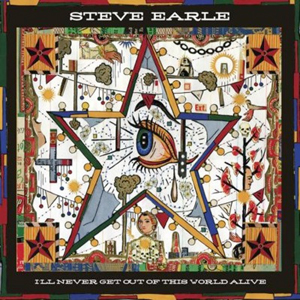
People want to hear what they know. Over and over. No one hires bands to play original music at their weddings. Unless they’re rich, then they hire big name bands to play music that people have heard over and over. I’m guilty of it. I settle in on specific album tracks and wear them out. Digital versions, of course. I wouldn’t do it to a favorite record. I’ve enjoyed most of what Steve Earle has produced in his career, but I’ve been secretly hoping for him to revisit the sound he found on “El Corazon.” It may never happen. Earle doesn’t seem too interested in repeating himself and he’s the one making the music so I’m the one doing the secret hoping. “I’ll Never Get Out Of This World Alive” might be as close as Earle ever gets in mood & timbre to “El Corazon.” If that’s the case, I’ll die happy enough. At least as far as my affinity for Steve Earle is concerned. I still have bad knees, but that’s a topic for a separate forum.
T-Bone Burnett turned the knobs during this recording and his fingerprints are all over it. Tremolo guitar work again lends a swamp vibe to the proceedings, but this swamp is safer than most. It’s like you’re riding in an air boat on a swamp tour, not like you’re wearing hip waders in the water with the snakes. At least until “Meet Me In The Alleyway.” Then, things get really murky. To me, the Tom Waits influence seems obvious enough especially after Earle’s cover of “Way Down In The Hole” from a few years back. “Alleyway” has more of a “Get Behind The Mule” vibe. And it’s a vibe I could hang with all day. Beyond that, all the usual suspects are present. There’s an Irish-tinged ode to love called “Molly-O,” and tales of wandering (“Waiting On The Sky,” “Lonely Are The Free,” and the aptly titled “I Am A Wanderer”), and a splash of environmental acknowledgement if not environmentalism (“The Gulf Of Mexico”). Earle’s brief essay in the liners explains that these songs were written over the course of three years that spanned the death of his father and that they all, in some way, focus on mortality. I didn’t pick up on that by listening. I’m more into mood than details as a generality, and the mood here, despite Earle’s Clift’s notes, is not morbid or depressing to me. I mean, it’s no disco record, but I don’t go searching for a bridge to jump off of when I hear it either. And that’s kinda Steve’s deal. He’s a little ornery, he’ll tackle the heavy issues unapologetically, but he does it all with some hope. Redemption always seems within reach. I don’t get the impression that he’s unhappy. I get the impression that he’s a thinker and a realist. “Realist” is tricky as a lot of people seem to think of it as pessimism in disguise. I think there’s a balance to be achieved & it’s one I’m aiming for too. Maybe that’s why I relate to Earle’s work while others get exasperated with the heavier elements of it. I’m glad he’s around to keep things balanced & I’m glad to add “…Never Get Out…” to the collection. It fits in nicely beside my copy of his “Townes.” A lot of his work is unavailable on vinyl as of now. I’ll hope that changes while I’m hoping for his next “El Corazon.” (How about we just release a high quality version of “El Corazon” and call it a draw, shall we?) If you’re unfamiliar with Earle, this is as good an intro as any. If you are familiar, you’ve got an opinion already whether it’s yours or someone else’s. If you’re on his side, you’ll want to pick this one up while it’s still available. If you’re anti-Earle, then you probably haven’t made it this far into the article anyway. Salud.
I like what New West Records does with their vinyl. I think they rank up there with Nonesuch as far as that goes. The most basic benefit is that you don’t have to replace their inner sleeves to protect the pressing that they obviously spent some extra time with. Unlike Nonesuch, you don’t get a CD of the recording to take with you. That omission is as glaring as the need for a quality inner sleeve is obvious. It seems like no one can get it right across the board. New West may justify the lack of a digital copy by suggesting that the vinyl was produced for audiophiles and so a CD wouldn’t pass muster anyway. I suggest that they want you to buy the same work twice. I’m not going to. I’ll wait until I run across a friend with the CD and I’ll burn it. These are songs I’d like to listen to in the car, maybe, but I refuse to let the companies win this battle. It would cost them all of $0.75 to include it, less if they provided you with a download coupon. But as a straight vinyl release, I can’t recommend this one enough. Burnett’s production sounds especially warm in this format. This would be a fine time to get into Steve Earle if you haven’t already. This, in my opinion, is what he does best. The forays into DJ accompaniment are fun, but this is the meat. I’m hoping to get a healthy sampling from this record at his Hardly Strictly Bluegrass Festival performance next Sunday. It’s the most wonderful time of the year…
Bob Dylan “The Original Mono Recordings” Columbia Records
- Performance:

- Sound:

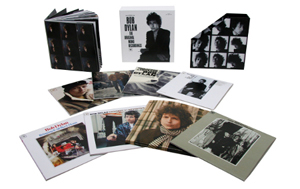
I don’t know why I waited so long to pick up “The Original Mono Recordings” which collects Bob Dylan’s first eight albums on high quality vinyl. I guess I have my favorite vinyl reissue companies in my mental Rolodex, and sometimes I don’t think too far outside that bubble. This set was put together by Columbia Records. They’re a giant corporation and not above a cash grab in my opinion. Many of their releases have been not very compelling. They aligned themselves with companies like Classic Records for Dylan sets in years past, but they handled this one on their own. And it was quite a project to take on. The first thing I noticed upon delivery is that it’s huge. I mean, it’s a party for your senses. I haven’t tasted it and it’s not particularly fragrant, but it’s got sight, sound, and touch all wrapped up in a magical box of wonder. It should come with a warning. Something along the lines of what employers give you when your job description regularly involves lifting more than thirty pounds. I’m a Dylan fan. That’s like saying Congress is divided. But I’ve not explored nearly all of his recorded output because, if things follow their natural order, I will outlive Bob Dylan and he will stop recording before I reach his age, and my only option will be to go in reverse and find what I’ve missed rather than what’s coming. That may sound a little zany to folks that aren’t enamored of his more recent material. I’m not among that faction. I’ve thoroughly enjoyed everything he’s done since “Time Out Of Mind.” Every bit as much as his more classic material. And more than what I expect to find when I get around to records like “Saved.” But you never know. And I didn’t know how compelling the “Mono” set was until recently. I know now. Hallelujah, I’ve seen the light.
Most of my favorite ’60s bands, the Stones, Beatles, and Zeppelin among them, began as cover bands, basically. Things were no different for Dylan except his source material was a little more obscure and less bluesy as a general rule. His first long player, “Bob Dylan,” is composed mostly of traditionals and covers. It’s just him and a guitar, and this is one that I’ve been mostly unfamiliar with until now. I’m not sure what they would have done with a stereo mix of this record as it’s just Bob and Bob’s Guitar. I’m a fan of mono recordings anyway, and this one is especially hot. It’s a blast to hear a master finding his voice in retrospect, and hearing Dylan work through his Woody Guthrie-isms is especially satisfying given the effects it would have on pop history. “The Freewheelin’ Bob Dylan” finds him finding himself topically as well as vocally, and shows a greater emphasis on politics. That last bit becomes even more apparent on “The Times They Are A-Changin'” which is Dylan’s first collection of all original material. This was right around the time of John Kennedy’s assassination, things were getting testy, and Dylan was in the center of the ring. Never one to be penned down or to bow to expectation, “Another Side Of Bob Dylan” veers from the political focus while still presenting Dylan as a solo acoustic performer. He takes another left turn with a full-on rock and roll band for what I consider his first masterpiece, “Bringing It All Back Home.” Good night, America. I can’t imagine what this must have meant to folks then. Even the cover is riddled with clues and mysteries which have been well documented forever. I’m most intrigued by the inclusion of the Robert Johnson album cover and Dylan’s own “Another Side…” which had come out about eight months prior. In fact, every record we’ve covered here so far was released within three years of each other, and the remaining three would require less time than that. Those are my favorites in this set and amongst my favorites ever. I mean, we’re talking about “Highway 61 Revisited,” “Blonde On Blonde,” and “John Wesley Harding.” Now, we’re rocking with full intention. Cooking with gas. On the front burner. Ready to explode without concern, remorse, or hesitation. These records, especially “61” and “Blonde” are documents of a man with his thing completely together. Probably no need to dig too deeply here. Most of the digging’s been done. I will say that if you’re a fan of real rock and roll or if you’re even the most basic pop music historian or even if you have a passing interest in ’60s culture, these two records are essential. No questions asked, hands down, 100% essential. Their influence cannot be overstated. Popular music simply would have developed along a totally different path without them. “Harding” floats my boat on a personal level, the other two are artifacts of a time that is among the most documented, studied, and revered in American history. I wish I could have seen it with my own eyes. I often wonder where I’d have stood, on which side of what line, and for how long. I’d like to think I’d have been well-informed, thoughtful with my humanity in focus, and that I wouldn’t have blown up any post offices. I’d like to think I’d have been influencing as much as being influenced, but all I have are these records and a few others like them to paint a vicarious picture of the whole beautiful mess. Today’s artists aren’t up for the task. The reports must suggest that you get a poor return on investment for work of any depth. That’s how you end up where we are now with regards to pop culture. Everybody knows this is nowhere. We jumped off the bridge in the ’80’s and we’re still falling. I’m not looking forward to rock bottom, but maybe we can at least start to rebuild once we find it. I’m not optimistic. That’s why sets like these mean so much to me. What do we have to look forward to 45 years from now? A collection of Coldplay’s first eight studio records? In stereo? Again? Wow. Thanks. Thanks for that. Maybe I’ll just find a short pier & take a long walk instead…
The box that houses this set will literally not be able to contain the brilliance of its contents forever. Maybe not for long. If it weren’t cost prohibitive, I’d suggest two boxes for this set as mine is already starting to fray from the weight of its load. Pulling it off the record shelf requires forethought and planning. Which way do you put it up? With the spine of the actual box or with the records’ spines facing out? How do you extract a single record from a set this size without upsetting the others? Do you tilt the whole set forward and risk dumping the records out in a catastrophic heap? Do you dig in with your fingers and risk damaging the box while you pry the chosen record loose from the others? The set is unwieldy. The set is brilliant. The records are pristine. The sound phenomenal. The extras include a substantial book of liners penned by Greil Marcus himself. Some of the inner sleeves are reproductions of the Columbia originals. The box includes a download coupon for the whole shooting match! In mono!! And I think that’s great. The mono bit, especially. I think some of the ’60s stereo recordings are distracting. As if the new technology was too irresistible to avoid tinkering with. Some of the more popular material with the full band treatment might be a little hard to grasp for some folks at first, but I think it’s preferable taken all around. It really balances things out for me and lets me focus on the business at hand. Which is rocking. Bob Dylan, whether as a folky or a Christian revivalist or a septuagenarian touring machine, has always been in the business of rocking. This set puts the first leg of that journey in a glorious perspective. It’s about time…


